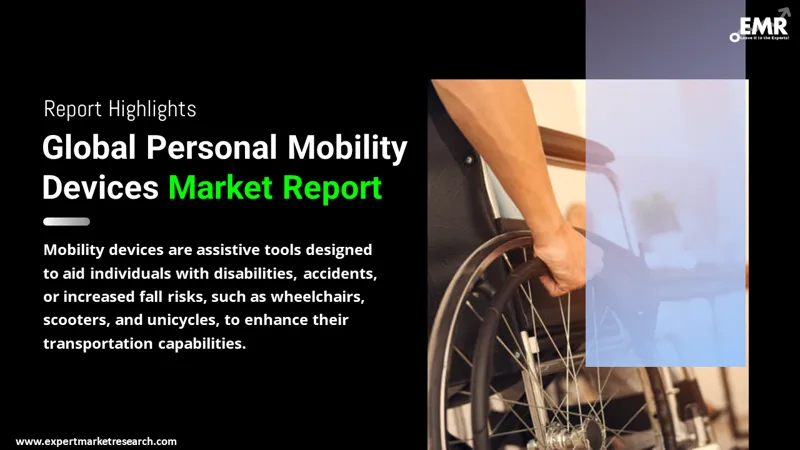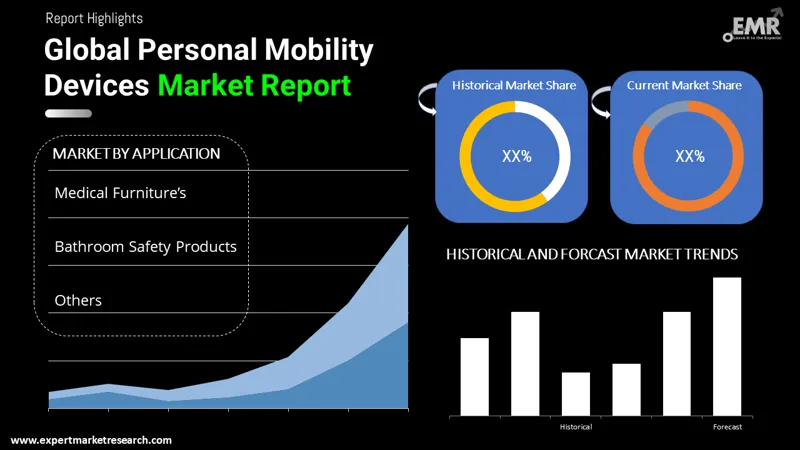
Consumer Insights
Uncover trends and behaviors shaping consumer choices today
Procurement Insights
Optimize your sourcing strategy with key market data
Industry Stats
Stay ahead with the latest trends and market analysis.
The global personal mobility devices market was valued at USD 11.46 Billion in 2025 driven by the increasing prevalence of chronic diseases and disabilities across the globe. The market is expected to grow at a CAGR of 9.60% during the forecast period 2026-2035 and attain a market value of USD 28.66 Billion by 2035.
Base Year
Historical Period
Forecast Period
The rising prevalence of chronic diseases that lead to mobility difficulties is boosting the demand for personal mobility devices.
There is a higher emphasis on improving personal mobility devices, by introducing lighter materials, longer battery life, and better maneuverability. Such advancements are expected to boost market value in the forecast period.
Increasing merger and acquisition activities are one of the major market trends. In June 2024, Drive DeVilbiss Healthcare acquired Mobility Designed, Inc., enhancing its innovative medical equipment portfolio by integrating cutting-edge industrial design expertise.
Compound Annual Growth Rate
9.6%
Value in USD Billion
2026-2035
*this image is indicative*
Mobility devices are support devices that facilitate the transportation of individuals with accidents or disabilities, or older adults with enhanced danger of falling, for example, wheelchairs, scooters, and unicycles. These devices are crucial for individuals who have restricted movement, enhancing self-reliance and enhancing overall well-being through aiding in everyday tasks and dealing with bodily restrictions.
The growing number of chronic illnesses, an older population, and increasing disabilities are pushing the demand for such devices. In addition to aiding physical movement, they also help in improving mental health by encouraging social integration and decreasing loneliness. Improvements in personal mobility devices, such as lighter materials, longer battery life, and better maneuverability, have increased their ease of use. Combining GPS tracking, remote control capabilities, and health monitoring features provides users with increased independence and safety. Innovative designs such as devices that can fold and be easily carried are targeted towards active individuals who travel often. Advancements in robotics and AI are creating more advanced mobility options like exoskeletons and self-balancing wheelchairs, improving user autonomy. These enhancements are broadening the capabilities of personal mobility devices to cater to a variety of requirements.

Read more about this report - REQUEST FREE SAMPLE COPY IN PDF
Surge in Chronic Diseases Boosts Market Growth
The World Health Organization reports that chronic diseases result in around 41 million deaths annually, making up 74% of total global deaths. The personal mobility devices market is growing due to the increase in chronic diseases such as arthritis, diabetes, and cardiovascular conditions. These diseases may lead to mobility limitations, necessitating wheelchairs, scooters, and walkers for autonomy. Arthritis reduces joint mobility, making movement difficult, while diabetes-related issues such as neuropathy impact balance. The market expansion is further enhanced by the extended use of mobility devices for chronic disease management.
Technological Advancements to Meet Rising Personal Mobility Devices Market Demand
Advancements in materials, design, and features enhance the efficiency and user-friendliness of devices for individuals with mobility impairments. Materials such as carbon fibre, which are lightweight and durable, make it easier to transport and use. Smart technologies such as GPS tracking and health monitoring offer independence and security. In February 2024, Honda combined personal mobility and virtual reality in the world's first extended reality mobility experience at SXSW 2024. The experience included the UNI-ONE, a hands-free personal mobility device controlled by shifting one's centre of gravity. Advancements in robotics and AI result in innovative solutions such as self-balancing wheelchairs and exoskeletons, enhancing mobility and assistance. These advancements are anticipated to bolster growth in the personal mobility devices market.
The market is witnessing several trends and developments to improve the current scenario. Some of the notable trends are as follows:
Growing Aging Population
The market is expanding as the older population faces physical decline and mobility issues associated with diseases like arthritis and muscle weakness. As the elderly population grows, especially in developed areas with improved healthcare access, there is an increasing need for mobility aids. The population change is motivated by a wish to enhance the quality of life and lower the possibility of falls due to restricted movement.
Rising Awareness and Accessibility
With increasing public health campaigns, healthcare recommendations, and digital platforms, an increasing number of people are looking for these devices to improve their quality of life and gain more independence. Mobility assistance devices are increasingly accessible through online vendors, speciality shops, and medical establishments. Improvements in technology and accessibility have resulted in these devices being more cost-effective and easier to use.
Increasing Prevalence of Disabilities
The rise in disabilities is leading to a growing need for assistive devices such as wheelchairs, scooters, canes, and walkers. Both congenital and acquired disabilities can restrict an individual's capacity for independent movement. Personal mobility devices are crucial for people with disabilities, enabling them to engage in everyday tasks, attend social gatherings, and uphold their independence. The importance of these devices in public spaces and transportation further highlights the push for inclusive designs.
Increasing Government Initiatives and Support
Government backing fuels expansion in the global market for personal mobility devices. Measures like subsidies, insurance, and tax benefits help make mobility aids easier to access and more affordable for individuals with disabilities, the elderly, and those with chronic illnesses. Accessible transportation and healthcare services are being implemented to foster inclusive environments. Public health initiatives increase knowledge about the advantages of mobility aids. These initiatives enhance users' quality of life and increase market demand.

Read more about this report - REQUEST FREE SAMPLE COPY IN PDF
Market Breakup by Product
Market Breakup by End User
Market Breakup by Region
Segmentation on the Basis of Product to Witness Growth
Based on products, the market is divided into wheelchairs, mobility scooters, canes, crutches, walkers, and other products. Wheelchairs are the most popular personal mobility devices and are expected to lead the market due to their ability to cater to a wide range of mobility impairments, from temporary to permanent. They offer enhanced mobility, comfort, and safety, making them essential for individuals with severe restrictions. Advancements in technology, such as powered and lightweight models, have increased their adoption.
Based on region, the market report covers North America, Europe, Asia-Pacific, Latin America, and Middle East and Africa. North America is expected to dominate the market driven by elevated incidence of chronic diseases, an older population, and robust healthcare system in the region. Technological advances and smart gadgets play a crucial role, alongside heightened consciousness, and availability through diverse distribution outlets in the area.
Europe is also poised to have a significant market share supported by the presence of a growing geriatric population and the prevalence of chronic diseases and disabilities in the area. Government backing for disability rights and financial aid for assistive tools contribute to the expansion of the market. The market in Asia-Pacific is swiftly growing because of increased government assistance for disabled individuals in the area, coupled with improved access and awareness.
The key features of the market report include patent analysis, grant analysis, funding, and investment analysis as well as strategic initiatives by the leading players. The major companies in the market are as follows:
Drive DeVilbiss Healthcare, founded in 2000, is a leading manufacturer of durable medical equipment with global offices, specializing in supplying medical equipment to government agencies. In June 2024, the company acquired Mobility Designed, Inc., enhancing its innovative medical equipment portfolio by integrating cutting-edge industrial design expertise. Mobility Designed is known for creating personal assistive devices like the M+D Comfort Crutch, which offers improved comfort for users.
Otto Bock is a German company, established in 1919. They manufacture and sell medical products for people with limited mobility such as prosthetics, orthotics, human mobility (wheelchairs, rehab solutions) and patient care.
Invacare Corporation, an American medical equipment manufacturer, partnered with Free Wheelchair Mission for Mobility in May 2024. This initiative was intended to provide wheelchairs to under-resourced countries globally. Invacare, a leader in mobility solutions, collaborates with the Irvine-based charity to make a positive impact worldwide.
Sunrise Medical is a global leader in producing and distributing a variety of manual and powered wheelchairs, mobility scooters, and customizable seating systems. They focus on creating innovative and high-quality mobility products to improve people's lives worldwide. With a wide range of options, including lightweight, pediatric, and specialized wheelchairs, they prioritize customization and comfort for individuals with diverse needs.
*Please note that this is only a partial list; the complete list of key players is available in the full report. Additionally, the list of key players can be customized to better suit your needs.*
Other players in the market are GF Health Products, Inc., Kaye Products Inc., Medline Industries Inc., Patricia Industries (Permobil), Pride Mobility Products Corporation, and Stryker Corporation.




*While we strive to always give you current and accurate information, the numbers depicted on the website are indicative and may differ from the actual numbers in the main report. At Expert Market Research, we aim to bring you the latest insights and trends in the market. Using our analyses and forecasts, stakeholders can understand the market dynamics, navigate challenges, and capitalize on opportunities to make data-driven strategic decisions.*
Get in touch with us for a customized solution tailored to your unique requirements and save upto 35%!
Explore our key highlights of the report and gain a concise overview of key findings, trends, and actionable insights that will empower your strategic decisions.
| REPORT FEATURES | DETAILS |
| Base Year | 2025 |
| Historical Period | 2019-2025 |
| Forecast Period | 2026-2035 |
| Scope of the Report |
Historical and Forecast Trends, Industry Drivers and Constraints, Historical and Forecast Market Analysis by Segment:
|
| Breakup by Product |
|
| Breakup by End User |
|
| Breakup by Region |
|
| Market Dynamics |
|
| Supplier Landscape |
|
| Companies Covered |
|
Datasheet
One User
USD 3,299
USD 2,969
tax inclusive*
Single User License
One User
USD 5,499
USD 4,949
tax inclusive*
Five User License
Five User
USD 6,999
USD 5,949
tax inclusive*
Corporate License
Unlimited Users
USD 8,199
USD 6,969
tax inclusive*
*Please note that the prices mentioned below are starting prices for each bundle type. Kindly contact our team for further details.*
Flash Bundle
Small Business Bundle
Growth Bundle
Enterprise Bundle
*Please note that the prices mentioned below are starting prices for each bundle type. Kindly contact our team for further details.*
Flash Bundle
Number of Reports: 3
20%
tax inclusive*
Small Business Bundle
Number of Reports: 5
25%
tax inclusive*
Growth Bundle
Number of Reports: 8
30%
tax inclusive*
Enterprise Bundle
Number of Reports: 10
35%
tax inclusive*
How To Order

Select License Type
Choose the right license for your needs and access rights.

Click on ‘Buy Now’
Add the report to your cart with one click and proceed to register.

Select Mode of Payment
Choose a payment option for a secure checkout. You will be redirected accordingly.
Gain insights to stay ahead and seize opportunities.

Get insights & trends for a competitive edge.

Track prices with detailed trend reports.

Analyse trade data for supply chain insights.

Leverage cost reports for smart savings

Enhance supply chain with partnerships.

Connect For More Information
Our expert team of analysts will offer full support and resolve any queries regarding the report, before and after the purchase.
Our expert team of analysts will offer full support and resolve any queries regarding the report, before and after the purchase.
We employ meticulous research methods, blending advanced analytics and expert insights to deliver accurate, actionable industry intelligence, staying ahead of competitors.
Our skilled analysts offer unparalleled competitive advantage with detailed insights on current and emerging markets, ensuring your strategic edge.
We offer an in-depth yet simplified presentation of industry insights and analysis to meet your specific requirements effectively.
Share